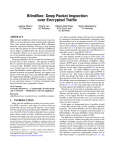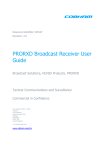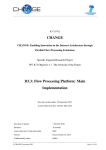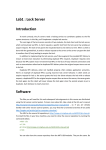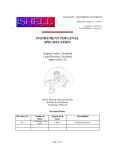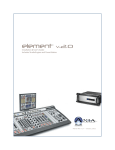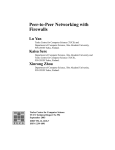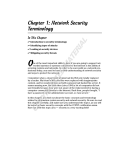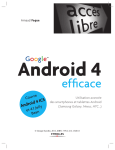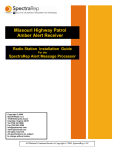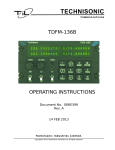Download BlindBox: Deep Packet Inspection over Encrypted Traffic
Transcript
BlindBox: Deep Packet Inspection
over Encrypted Traffic
Justine Sherry
Chang Lan
Raluca Ada Popa
Sylvia Ratnasamy
UC Berkeley
UC Berkeley
ETH Zürich and
UC Berkeley
UC Berkeley
ABSTRACT
Many network middleboxes perform deep packet inspection
(DPI), a set of useful tasks which examine packet payloads.
These tasks include intrusion detection (IDS), exfiltration
detection, and parental filtering. However, a long-standing
issue is that once packets are sent over HTTPS, middleboxes
can no longer accomplish their tasks because the payloads
are encrypted. Hence, one is faced with the choice of only
one of two desirable properties: the functionality of middleboxes and the privacy of encryption.
We propose BlindBox, the first system that simultaneously
provides both of these properties. The approach of BlindBox is to perform the deep-packet inspection directly on the
encrypted traffic. BlindBox realizes this approach through
a new protocol and new encryption schemes. We demonstrate that BlindBox enables applications such as IDS, exfiltration detection and parental filtering, and supports real
rulesets from both open-source and industrial DPI systems.
We implemented BlindBox and showed that it is practical
for settings with long-lived HTTPS connections. Moreover,
its core encryption scheme is 3-6 orders of magnitude faster
than existing relevant cryptographic schemes.
CCS Concepts
• Security and privacy → Cryptography; Security protocols; • Networks → Middleboxes / network appliances;
Keywords
middlebox privacy; network privacy; searchable encryption
1.
INTRODUCTION
Many network middleboxes perform deep packet inspection (DPI) to provide a wide range of services which can
benefit both end users and network operators. For example,
Network Intrusion Detection/Prevention (IDS/IPS) systems
(e.g., Snort [9] or Bro [38]) detect if packets from a compromised sender contain an attack. Exfiltration prevention de-
ACM ISBN X-XXXXX-XX-X/XX/XX.
DOI: 10.1145/1235
vices block accidental leakage of private data in enterprises
by searching for document confidentiality watermarks in the
data transferred out of an enterprise network [46]. Parental
filtering devices prevent children from accessing adult material in schools, libraries, and homes [13]. These devices and
many others [6, 8, 7] all share the common feature that they
inspect packet payloads; the market for such DPI devices is
expected to grow to over $2B by 2018 [45].
At the same time, HTTPS and other encryption protocols
have seen dramatic growth in usage in recent years [37];
encryption protects users’ private data from eavesdroppers
anywhere in the network, including at a middlebox. Unfortunately, HTTPS poses a long-standing challenge for DPI
devices. Since packet payloads are encrypted, network middleboxes can no longer inspect payloads [37] and accomplish their tasks. To enable middlebox processing, some
currently deployed middlebox systems support HTTPS in
an insecure way: they mount a man-in-the-middle attack
on SSL and decrypt the traffic at the middlebox [30, 29].
This approach violates the end-to-end security guarantees of
SSL and thus causes an unfortunate set of issues as surveyed
in [30]. Moreover, users and clients have criticized this approach [52, 33, 43, 49], some expressing worry that the private data logged at the middlebox is given to marketers.
Therefore, one is faced with an unfortunate choice of only
one of two desirable properties: the functionality of the middleboxes and the privacy given by encryption. At a first
glance, it may appear that these two properties are fundamentally at odds with each other: how can a network appliance make decisions based on connection contents when it
cannot see these contents?
In this paper, we demonstrate that it is possible to build
a system that satisfies both of these seemingly conflicting
properties. We present BlindBox, the first system that provides both the benefits of encryption and functionality at a
DPI middlebox. The name “BlindBox” denotes that the middlebox cannot see the private content of traffic.
Our approach is to perform the inspection directly on the
encrypted payload, without decrypting the payload at the
middlebox. Building a practical such system is challenging:
networks operate at very high rates requiring cryptographic
operations on the critical path to run in micro or even nano
seconds; further, some middleboxes require support for rich
operations, such as matching regular expressions. A potential candidate is expressive cryptographic schemes such as
fully homomorphic or functional encryption [25, 24, 28],
but these are prohibitively slow, decreasing network rates by
many orders of magnitude.
To overcome these challenges, BlindBox explores and specializes on the network setting. BlindBox enables two classes
of DPI computation each having its own privacy guarantees:
exact match privacy and probable cause privacy. Both of
BlindBox’s privacy models are much stronger than the stateof-the-art “man in the middle" approach deployed today. In
both of these models, BlindBox protects the data with strong
randomized encryption schemes providing similar security
guarantees to the well-studied notion of searchable encryption [47, 31]. Depending on the class of computation, BlindBox allows the middlebox to learn a small amount of information about the traffic to detect rules efficiently.
The first class of computation consists of DPI applications
that rely only on exact string matching, such as watermarking, parental filtering, and a limited IDS. Under the associated privacy model, exact match privacy, the middlebox
learns at which positions in a flow attack keywords occur;
for substrings of the flow that do not match an attack keyword, the middlebox learns virtually nothing.
The second class of computation can support all DPI applications, including those which perform regular expressions or scripting. The privacy model here, probable cause
privacy, is a new network privacy model: the middlebox
gains the ability to see a (decrypted) individual packet or
flow only if the flow is suspicious; namely, the flow contains
a string that matches a known attack keyword. If the stream
is not suspicious, the middlebox cannot see the (decrypted)
stream. Hence, privacy is affected only with a cause. In
practice, most traffic remains encrypted. BlindBox allows
users to select which privacy model they are most comfortable with.
To implement these two models, we developed the following techniques:
• DPIEnc and BlindBox Detect are a new searchable encryption scheme [47] and an associated fast detection protocol, which can be used to inspect encrypted traffic for
certain keywords efficiently. As we explain in §3, existing
searchable encryption schemes [47, 31, 15] are either deterministic (which can enable fast protocols, but provide
weak security) or randomized (which have stronger security, but are slow in our setting). DPIEnc with BlindBox
Detect achieve both the speed of deterministic encryption
and the security of randomized encryption; detection on
encrypted traffic runs as fast as on unencrypted traffic.
• Obfuscated Rule Encryption is a technique to allow the
middlebox to obtain encrypted rules based on the rules
from the middlebox and the private key of the endpoints,
without the endpoints learning the rules or the middlebox
learning the private key. This technique builds on Yao’s
garbled circuits [51] and oblivious transfer [36, 41, 23].
• Probable Cause Decryption is a mechanism to allow flow
decryption when a suspicious keyword is observed in the
flow; this is the mechanism that allows us to implement
our probable cause privacy model.
We implemented BlindBox as well as a new secure trans-
port protocol for HTTP, which we call BlindBox HTTPS.
We evaluated BlindBox HTTPS using several real DPI applications: data watermarking [46], parental filtering, and intrusion detection. We used attack signatures from the opensource community (Snort [9]) and industrial IDSes (McAfee
Stonesoft and Lastline).
We show that BlindBox’s performance is practical for many
settings. For example, the rate at which the middlebox can
inspect packets is as high as 186Mbps per core in our experiments. Given that standard IDS implementations, such
as Snort [9], peak at under 100Mbps, this performance is
competitive with existing deployments. We achieve this performance due to DPIEnc and BlindBox Detect. When compared to two strawmen consisting of a popular searchable encryption scheme [47] and a functional encryption scheme [32],
DPIEnc with BlindBox Detect are 3-6 orders of magnitude
faster. Nevertheless, a component of BlindBox is not yet as
fast as desirable: the setup of an HTTPS connection. This
setup performs obfuscated rule encryption and it takes time
proportional to the number of attack rules. For rulesets with
tens of keywords, this setup completes in under a second;
however, for large IDS installations with thousands of rules,
the setup can take up to 1.5 minutes to complete. Hence,
BlindBox is most fit for settings using long or persistent connections through SPDY-like protocols or tunneling, and not
yet practical for short, independent flows with many rules.
We see BlindBox as a first step towards a general protocol that will allow middleboxes and end-to-end encryption
to coexist, without sacrificing the benefits of either. BlindBox shows that this coexistence is possible for the class of
middleboxes performing deep packet inspection. A future,
general protocol will devise mechanisms to address the full
range of middleboxes including those that process packet
headers, modify packet payloads (such as transcoders and
WAN optimizers), or terminate sessions (such as Web or SIP
proxies). Consequently, the subject of our current and future
work focuses on achieving this end goal: a general protocol
to allow all middleboxes to coexist with encryption.
2.
OVERVIEW
Fig. 1 presents the system architecture. There are four
parties: sender (S), receiver (R), middlebox (MB), and rule
generator (RG) – these reflect standard middlebox deployments today. RG generates attack rules (also called signatures) to be used by MB in detecting attacks. Each rule attempts to describe an attack and it contains fields such as:
one or more keywords to be matched in the traffic, offset information for each keyword, and sometimes regular expressions. The RG role is performed today by organizations like
Emerging Threats [3], McAfee [4], or Symantec [11]. S and
R send traffic through MB. MB allows S and R to communicate unless MB observes an attack rule in their traffic.
Network administrators today deploy in-network middleboxes in this way because it gives them a central point of
control to enforce security policies in their network (since
they often do not control the endpoints). Moreover, having a single in-network device is also easy to manage and
rule generator
rules
rule preparation
encrypted rules
encrypt
tokenize
encrypted tokens
traffic
SSL
encrypted traffic
sender
detect
validate
tokens
SSL
middlebox
traffic
receiver
Figure 1: System architecture. Shaded boxes indicate algorithms added by BlindBox.
upgrade. Some research [22] considered alternative (edge)
deployments in which endpoints perform all middlebox processing on their own traffic and rules are distributed to the
endpoints. BlindBox instead aims to make changes compatible with the network approach in widespread use today.
Further, this edge-based model is not compatible with the
requirement of keeping rules hidden from endpoints, which
we discuss in §2.2.1.
In today’s deployments, MB can read any traffic sent between S and R. With BlindBox, MB should be able to detect
if attack rules generated by RG match the traffic between R
and S, but should not learn the contents of the traffic that
does not match RG’s attack rules.
2.1
Usage Scenarios
Before formalizing our threat model, we illustrate our usage scenario with three examples. For each individual in
these examples, we indicate the party in our model (R, S,
MB, or RG) that they correspond to.
Example #1: University Network. Alice (R or S) is a student at the University of SIGCOMM and brings her own laptop to her dorm room. However, university policy requires
that all student traffic be monitored for botnet signatures and
illegal activity by a middlebox (MB) running an IDS. Alice is worried about her computer being infected with botnet
software, so she also desires this policy applied to her traffic.
McAfee (RG) is the service that provides attack rules to the
middlebox and Alice trusts it. However, she is uncomfortable with the idea of someone she doesn’t know (who has
access to the middlebox) potentially being able to read her
private Facebook messages and emails. Alice installs BlindBox HTTPS with McAfee’s public key, allowing the IDS
to scan her traffic for McAfee’s signatures, but not read her
private messages.
Example #2: ISP Service. Bob has two young children
(S or R) at home, and registers for parental filtering with
his ISP so that all traffic is filtered for adult content. However, Bob has read stories in the news of ISPs selling user
browsing data to marketers [49] and wants to prevent his ISP
(MB) from using his data in this way. Bob trusts the Electronic Filtering Foundation (RG), a non-profit which generates rulesets for filtering and pledges not to sell user data.
Bob installs BlindBox HTTPS on his home computer with
the Electronic Filtering Foundation’s public key, allowing
his traffic to be scanned for EFF rules, but no other data.
In the above examples, Alice and Bob want to have a middlebox in their network check for the attack rules the corre-
sponding trusted parties permit, but the middlebox should
not learn anything else about the content of the traffic. A
key requirement is that there exists an RG which Alice, Bob
and the MB trust with rule generation; if this is not the case,
the parties cannot use BlindBox.
Anti-Example #1: Political Dissident. Charlie (R or S) is
a political dissident who frequently browses sensitive websites, and is concerned about government monitoring. If the
government coerces one of MB or RG, Charlie remains protected. However, BlindBox should not be used in a setting in
which both MB and RG can be controlled by an attacker: in
this case, RG can produce signatures for sensitive terms and
MB will use these to match the traffic. Hence, if the government can coerce both MB and RG together, Charlie should
not use BlindBox. Similarly, if the government can coerce
root certificate generators, Charlie should not use vanilla
HTTPS either because it may allow man-in-the-middle attacks on his traffic.
2.2
Security and Threat Model
The goal of our work is to protect the privacy of user traffic from MB. Any solution must satisfy a set of systems requirements we discuss in §2.2.1. We then discuss the threat
model in §2.2.2 and the privacy guarantees BlindBox provides in §2.2.3.
2.2.1
System Requirements
BlindBox retains key system goals of traditional IDS deployments today: (1) BlindBox must maintain MB’s ability
to enforce its policies (i.e., detect rules and drop/alert accordingly), and (2) endpoints must not gain access to the
IDS rules. The rationale behind the second requirement is
twofold. First, in order to make IDS evasion more difficult
for an attacker at the user, the rules should be hidden from
the endpoints [38]. Second, most vendors (e.g., Lastline and
McAfee Stonesoft) rely on the secrecy of their rulesets in
their business model, as their value added against competitors often includes more comprehensive, more efficient, or
harder to evade rules.
BlindBox maintains these two requirements, and adds an
additional one: (3) that the middlebox cannot read the user’s
traffic, except the portions of the traffic which are considered
suspicious based on the attack rules.
2.2.2
Threat Model
There are two types of attackers in our setup.
The original attacker considered by IDS. This is the same
attacker that traditional (unencrypted) IDS consider and we
do not change the threat model here. Our goal is to detect
such an attacker over encrypted traffic. As in traditional
IDS, one endpoint can behave maliciously, but at least one
endpoint must be honest. This is a fundamental requirement
of any IDS [38] because otherwise two malicious endpoints
can agree on a secret key and encrypt their traffic under that
key with a strong encryption scheme, making prevention impossible by the security properties of the encryption scheme.
Similarly, the assumption that one endpoint is honest is also
the default for exfiltration detection and parental filtering today. Parental filters can assume one endpoint is innocent under the expectation that 8-year-olds are unlikely replace their
network protocol stack or install tunneling software. Commercial exfiltration detection devices primarily target accidental exfiltration (e.g., where an otherwise innocent employee attaches the wrong file to an email), recognizing that
deliberate exfiltration requires control of the end host.
The attacker at the middlebox. This is the new attacker
in our setting. This attacker tries to subvert our scheme by
attempting to extract private data from the encrypted traffic
passing through the middlebox. We assume that the middlebox MB performs the detection honestly, but that it tries
to learn private data from the traffic and violate the privacy
of the endpoints. In particular, we assume that an attacker
at MB reads all the data accessible to the middlebox, including traffic logs and other state. Given this threat model,
BlindBox’s goal is to hide the content of the traffic from MB,
while allowing MB to do DPI. We do not seek to hide the attack rules from the MB itself; many times these rules are
hardcoded in the MB.
2.2.3
Privacy Models
We now describe our privacy models.
Exact Match Privacy gives the following guarantee: the
middlebox will be able to discover only those substrings of
the traffic that are exact matches for known attack keywords.
For example, if there exists a rule for the word “ATTACK”,
the middlebox will learn at which offset in the flow the word
“ATTACK” appears (if it appears), but does not learn what
the other parts of the traffic are. Traffic which does not match
a suspicious keyword remains unreadable to the middlebox.
Probable Cause Privacy gives a different guarantee: that
the middlebox will be able to decrypt a flow only if a substring of the flow is an exact match for a known attack keyword. Probable cause privacy is useful for IDS tasks which
require regular expressions or scripting to complete their analysis. This model is inspired from two ideas. First, it is inspired from the notion of probable cause from United States’
criminal law: one should give up privacy only if there is
a reason for suspicion. Second, most rules in Snort that
contain regular expressions first attempt to find a suspicious
keyword in the packet – this keyword is selective so only a
small fraction of the traffic matches this string and is passed
through the regexp. Indeed, the Snort user manual [48] urges
the presence of such selective keywords because otherwise,
detection would be too slow. Since rules are structured this
way, it becomes easier to implement our probable cause pri-
vacy model by decrypting the stream if there is a match to
the suspicious keyword.
Exact match privacy provides security guarantees as in
searchable encryption [47], which are well-studied. Probable cause privacy is a new privacy model, and we believe
it may be useful in other network domains beyond middleboxes (e.g. network forensics or search warrants), although
we leave such investigation to future work. We formalize
and prove the security guarantees of BlindBox using standard indistinguishability-based definitions in the Appendix.
Both models are stronger than the “man in the middle” approach in deployment today, where all traffic is decrypted
regardless of suspicion. A user who prefers exact match
privacy over probable cause privacy can indicate so within
BlindBox HTTPS.
2.3
System Architecture
We now return to Fig. 1 to explain each module and how
BlindBox functions from a high level; we delve into the protocol and implementation details in the following sections.
Prior to any connection, RG generates a set of rules which
contain a list of suspicious keywords known to formulate
parts of attacks; RG signs these rules with its private key
and shares them with MB, its customer. S and R, who trust
RG, install a BlindBox HTTPS configuration which includes
RG’s public key. Beyond this initial setup, RG is never directly involved in the protocol. We now discuss the interactions between R, S, and MB when R and S open a connection
in a network monitored by MB.
Connection setup. First, the sender and receiver run the
regular SSL handshake which permits them to agree on a
key k0 . The sender and receiver use k0 to derive three keys
(e.g., using a pseudorandom generator):
• kSSL : the regular SSL key, used to encrypt the traffic as
in the SSL protocol,
• k: used in our detection protocol, and
• krand : used as a seed for randomness. Since both endpoints have the same seed, they will generate the same
randomness.
At the same time, MB performs its own connection setup
to be able to perform detection over S and R’s traffic. In
an exchange with S and R, MB obtains each rule from RG
deterministically encrypted with key k – this will later enable MB to perform the detection. However, this exchange
occurs in such a way that MB does not learn the value of k
and in such a way that R and S do not learn what the rules
are. We call this exchange obfuscated rule encryption and
we describe how it is implemented in the following section.
Unlike the above handshake between S and R, which bootstraps off the existing SSL handshake, obfuscated rule encryption is a new exchange. In existing deployments, clients
typically do not communicate directly with DPI middleboxes
(although for other kinds of middleboxes, such as explicit
proxies [17] or NAT hole-punching [21], they may do so).
Even though this step removes the complete “transparency”
of the DPI appliance, it is an incremental change that we
consider an acceptable tradeoff for the benefits of BlindBox.
Sending traffic. To transmit, the sender: (1) encrypts the
traffic with SSL as in a non-BlindBox system; (2) tokenizes
the traffic by splitting it in substrings taken from various offsets (as discussed in §3); and (3) encrypts the resulting tokens using our DPIEnc encryption scheme.
Detection. The middlebox receives the SSL-encrypted traffic and the encrypted tokens. The detect module will search
for matchings between the encrypted rules and the encrypted
tokens using BlindBox Detect (Sec. 3.2). If there is a match,
one can choose the same actions as in a regular (unencrypted
IDS) such as drop the packet, stop the connection, or notify
an administrator. After completing detection, MB forwards
the SSL traffic and the encrypted tokens to the sender.
Receiving traffic. Two actions happen at the receiver. First,
the receiver decrypts and authenticates the traffic using regular SSL. Second, the receiver checks that the encrypted tokens were encrypted properly by the sender. Recall that, in
our threat model, one endpoint may be malicious – this endpoint could try to cheat by not encrypting the tokens correctly or by encrypting only a subset of the tokens to eschew
detection at the middlebox. Since we assume that at least one
endpoint is honest, such verification will prevent this attack.
Because BlindBox only supports attack rules at the HTTP
application layer, this check is sufficient to prevent evasion.
Almost all the rules in our datasets were in this category.
Nonetheless, it is worth noting that, if an IDS were to support rules that detected attacks on the client driver or NIC
– before verification –, an attacker could evade detection by
not tokenizing.
2.4
Protocols
BlindBox provides three protocols. In Protocol I, a rule
consists of one keyword. MB must be able to detect if the
keyword appears at any offset in the traffic based on equality match. This protocol suffices for document watermarking [46] and parental filtering [13] applications, but can support only a few IDS rules. In Protocol II, a rule consists of
multiple keywords as well as position information of these
keywords. This protocol supports a wider class of IDS rules
than Protocol I, as we elaborate in §7. Protocol I and II provide Exact Match Privacy, as discussed in §2.2.3. Protocol
III additionally supports regular expressions and scripts, thus
enabling a full IDS. Protocol III provides Probable Cause
Privacy, as discussed in §2.2.3.
3.
PROTOCOL I: BASIC DETECTION
Protocol I enables matching a suspicious keyword against
the encrypted traffic. An attack rule in this protocol consists
of one keyword. Even though this protocol is the simplest of
our protocols, it introduces the majority of our techniques.
The other protocols extend Protocol I.
To detect a keyword match on encrypted text, one naturally considers searchable encryption [47, 31]. However,
existing searchable encryption schemes do not fit our setting
for two reasons. First, the setup of searchable encryption requires the entity who has the secret key to encrypt the rules;
this implies, in our setting, that the endpoints see the rules
(which is not allowed as discussed in §2.2.2). Our obfuscated rule encryption addresses this problem.
Second, none of the existing schemes meet both of our
security and network performance requirements. There are
at least two kinds of searchable encryption schemes: deterministic and randomized. Deterministic schemes [15] leak
whether two words in the traffic are equal to each other (even
if they do not match a rule). This provides weak privacy because it allows an attacker to perform frequency analysis. At
the same time, these schemes are fast because they enable
MB to build fast indexes that can process each token (e.g.
word) in a packet in time logarithmic in the number of rules.
On the other hand, randomized schemes [47, 31] provide
stronger security guarantees because they prevent frequency
analysis by salting ciphertexts. However, the usage of the
salt in these schemes requires combining each token with
each rule, resulting in a processing time linear in the number
of rules for each token; as we show in §7, this is too slow for
packet processing. In comparison, our encryption scheme
DPIEnc and detection protocol BlindBox Detect achieve the
best of both worlds: the detection speed of deterministic encryption and the security of randomized encryption.
Let us now describe how each BlindBox module in Fig. 1
works in turn. Recall that S and R are the sender and receiver, MB the middlebox and RG the rule generator.
Tokenization. The first step in the protocol is to tokenize
the input traffic. We start with a basic tokenization scheme,
which we refer to as “window-based” tokenization because
it follows a simple sliding window algorithm. For every offset in the bytestream, the sender creates a token of a fixed
length: we used 8 bytes per token in our implementation.
For example, if the packet stream is “alice apple”, the sender
generates the tokens “alice ap”, “lice app”, “ice appl”, and
so on. Using this tokenization scheme, MB will be able to
detect rule keywords of length 8 bytes or greater. For a keyword longer than 8 bytes, MB splits it in substrings of 8
bytes, some of which may overlap. For example, if a keyword is “maliciously”, MB can search for “maliciou” and
“iciously”. Since each encrypted token is 5 bytes long and
the endpoint generates one encrypted token per byte of traffic, the bandwidth overhead of this approach is of 5×.
We can reduce this bandwidth overhead by introducing
some optimizations. First, for an HTTP-only IDS (which
does not analyze arbitrary binaries), we can have senders ignore tokenization for images and videos which the IDS does
not need to analyze. Second, we can tailor our tokenization
further to the HTTP realm by observing how the keywords
from attack rules for these protocols are structured. The keywords matched in rules start and end before or after a delimiter. Delimiters are punctuation, spacing, and special symbols. For example, for the payload “login.php?user=alice”,
possible keywords in rules are typically “login”, “login.php”,
“?user=”, “user=alice”, but not “logi" or “logi.ph”. Hence,
the sender needs to generate only those tokens that could
match keywords that start and end on delimiter-based offsets; this allows us to ignore redundant tokens in the window.
We refer to this tokenization as “delimiter-based" tokeniza-
tion. In §7, we compare the overheads and coverage of these
two tokenization protocols.
with 10000 keywords to match, a logarithmic lookup is four
orders of magnitude faster than a linear scan.
3.1
3.2
The DPIEnc Encryption Scheme
In this subsection, we present our new DPIEnc encryption
scheme, which is used by the Encrypt module in Fig. 1. The
sender encrypts each token t obtained from the tokenization
with our encryption scheme. The encryption of a token t in
DPIEnc is:
salt, AESAESk (t) (salt) mod RS,
(1)
where salt is a randomly-chosen value and RS is explained
below.
Let us explain the rationale behind DPIEnc. For this purpose, assume that MB is being handed, for each rule r, the
pair (r, AESk (r)), but not the key k. We explain in §3.3 how
MB actually obtains AESk (r).
Let’s start by considering a simple deterministic encryption scheme instead of DPIEnc: the encryption of t is AESk (t).
Then, to check if t equals a keyword r, MB can simply check
?
if AESk (t) = AESk (r). Unfortunately, the resulting security
is weak because every occurrence of t will have the same ciphertext. To address this problem, we need to randomize the
encryption.
Hence, we use a “random function" H together with a random salt, and the ciphertext becomes: salt, H(salt, AESk (t)).
Intuitively, H must be pseudorandom and not invertible. To
perform a match, MB can then compute H(salt, AESk (r))
based on AESk (r) and salt, and again perform an equality
check. The typical instantiation of H is SHA-1, but SHA-1
is not as fast as AES (because AES is implemented in hardware on modern processors) and can reduce BlindBox’s network throughput. Instead, we implement H with AES, but
this must be done carefully because these primitives have
different security properties. To achieve the properties of H,
AES must be keyed with a value that MB does not know
when there is no match to an attack rule – hence, this value
is AESk (t). Our algorithm is now entirely implemented in
AES, which makes it fast.
Finally, RS simply reduces the size of the ciphertext to
reduce the bandwidth overhead, but it does not affect security. In our implementation, RS is 240 , yielding a ciphertext
length of 5 bytes. As a result, the ciphertext is no longer
decryptable; this is not a problem because BlindBox always
decrypts the traffic from the primary SSL stream.
Now, to detect a match between a keyword r and an encryption of a token t, MB computes AESAESk (r) (salt) mod
RS using salt and its knowledge of AESk (r), and then tests
for equality with AESAESk (t) (salt) mod RS.
Hence, naïvely, MB performs a match test for every token
t and rule r, which results in a performance per token linear in the number of rules; this is too slow. To address this
slowdown, our detection algorithm below makes this cost
logarithmic in the number of rules, the same as for vanilla
inspection of unencrypted traffic. This results in a significant performance improvement: for example, for a ruleset
BlindBox Detect Protocol
We now discuss how our detection algorithm achieves logarithmic lookup times, resolving the tension between security and performance. For simplicity of notation, denote
Enck (salt, t) = AESAESk (t) (salt).
The first idea is to precompute the values Enck (salt, r) for
every rule r and for every possible salt. Recall that MB can
compute Enck (salt, r) based only on salt and its knowledge
of AESk (r), and MB does not need to know k. Then, MB
can arrange these values in a search tree. Next, for each encrypted token t in the traffic stream, MB simply looks up
Enck (salt, t) in the tree and checks if an equal value exists.
However, the problem is that enumerating all possible salts
for each keyword r is infeasible. Hence, it would be desirable to use only a few salts, but this strategy affects security:
an attacker at MB can see which token in the traffic equals
which other token in the traffic whenever the salt is reused
for the same token. To maintain the desired security, every
encryption of a token t must contain a different salt (although
the salts can repeat across different tokens).
To use only a few salts and maintain security at the same
time, the idea is for the sender to generate salts based on the
token value and no longer send the salt in the clear along
with every encrypted token. Concretely, the sender keeps a
counter table mapping each token encrypted so far to how
many times it appeared in the stream so far. Before sending
encrypted tokens, the sender sends one initial salt, salt0 , and
MB records it. Then, the sender no longer sends salts; concretely, for each token t, the sender sends Enck (salt, t) but
not salt. When encrypting a token t, the sender checks the
number of times it was encrypted so far in the counter table,
say ctt , which could be zero. It then encrypts this token with
the salt (salt0 + ctt ) by computing Enck (salt0 + ctt , t). Note
that this provides the desired security because no two equal
tokens will have the same salt.
For example, consider the sender needs to encrypt the tokens A, B, A. The sender computes and transmits: salt0 ,
Enck (salt0 , A), Enck (salt0 , B), and Enck (salt0 + 1, A). Not
sending a salt for each ciphertext both reduces bandwidth
and is required for security: if the sender had sent salts, MB
could tell that the first and second tokens have the same salt,
hence they are not equal.
To prevent the counter table from growing too large, the
sender resets it every P bytes sent. When the sender resets
this table, the sender sets salt0 ← salt0 + maxt ctt + 1 and
announces the new salt0 to MB.
For detection, MB creates a table mapping each keyword
r to a counter ct∗r indicating the number of times this keyword r appeared so far in the traffic stream. MB also creates
a search tree containing the encryption of each rule r with
a salt computed from ct∗r : Enck (salt0 + ct∗r , r). Whenever
there is a match to r, MB increments ct∗r , computes and inserts the new encryption Enck (salt0 + ct∗r , r) into the tree,
and deletes the old value. We now summarize the detection
algorithm.
BlindBox Detect: The state at MB consists of the counters ct∗r for each rule r and a fast search tree made of
Enck (salt0 + ct∗r , r) for each rule r.
1: For each encrypted token Enck (salt, t) in a packet:
1.1: If Enck (salt, t) is in the search tree:
1.1.1: There is a match, so take the corresponding action for this match.
1.1.2: Delete the node in tree corresponding to
r and insert Enck (salt0 + ct∗r + 1, t)
1.1.3: Set ct∗r ← ct∗r + 1
With this strategy, for every token t, MB performs a simple tree lookup, which is logarithmic in the number of rules.
Other tree operations, such as deletion and insertion, happen rarely: when a malicious keyword matches in the traffic.
These operations are also logarithmic in the number of rules.
3.3
Rule Preparation
The detection protocol above assumes that MB obtains
AESk (r) for every keyword r, every time a new connection
(having a new key k) is setup. But how can MB obtain these
values? The challenge here is that no party, MB or S/R,
seems fit to compute AESk (r): MB knows r, but it is not
allowed to learn k; S and R know k, but are not allowed to
learn the rule r (as discussed in §2.2.2).
Intuition. We provide a technique, called obfuscated rule
encryption, to address this problem. The idea is that the
sender provides to the middlebox an “obfuscation” of the
function AES with the key k hardcoded in it. This obfuscation hides the key k. The middlebox runs this obfuscation
on the rule r and obtains AESk (r), without learning k. We
denote this obfuscated function by ObfAESk .
Since practical obfuscation does not exist, we implement
it with Yao garbled circuits [51, 35], on which we elaborate below. With garbled circuits, MB cannot directly plug
in r as input to ObfAESk (); instead, it must obtain from
the endpoints an encoding of r that works with ObfAESk .
For this task, the sender uses a protocol called oblivious
transfer [36, 14], which does not reveal r to the endpoints.
Moreover, MB needs to obtain a fresh, re-encrypted garbled
circuit ObfAESk () for every keyword r; the reason is that
the security of garbled circuits does not hold if MB receives
more than one encoding for the same garbled circuit.
A problem is that MB might attempt to run the obfuscated encryption function on rules of its choice, as opposed
to rules from RG. To prevent this attack, rules from RG must
be signed by RG and the obfuscated (garbled) function must
check that there is a valid signature on the input rule before
encrypting it. If the signature is not valid, it outputs null.
Let us now present the building blocks and our protocol
in more detail.
Yao garbling scheme [51, 35]. At a high level, a garbled
circuit scheme, first introduced by Yao, consists of two algorithms Garble and Eval. Garble takes as input a function F
with n bits of input and outputs a garbled function ObfF and
garble
AESk
L0 ...
1
L1 ...
1
L0
n
L1
n
oblivious transfer
Lr 1 Lr 2
1 2
...
Lr n
n
garbled
circuit AESk
endpoint
middlebox
AESk(r)
Figure 2: Rule preparation. The endpoint has a key k
and the middlebox has a keyword r.
n pairs of labels (L01 , L11 ), . . . , (L0n , L1n ), one pair for every
input bit of F . Consider any input x of n bits with xi being
its i-th bit. ObfF has the property that ObfF(Lx1 1 , . . . , Lxnn ) =
F (x). Basically, ObfF produces the same output as F if
given the labels corresponding to each bit of x. Regarding
security, ObfF and Lx1 1 , . . . , Lxnn do not leak anything about
F and x beyond F (x), as long as an adversary receives labels for only one input x.
1-out-of-2 oblivious transfer (OT) [36, 14]. Consider that a
party A has two values, L0 and L1 , and party B has a bit b.
Consider that B wants to obtain the b-th label from A, Lb ,
but B does not want to tell b to A. Also, A does not want B
to learn the other label L1−b . Hence, B cannot send b to A
and A cannot send both labels to B. Oblivious transfer (OT)
enables exactly this: B can obtain Lb without learning L1−b
and A does not learn b.
Rule preparation. Fig. 2 illustrates the rule preparation process for one keyword r. One endpoint could be malicious
and attempt to perform garbling incorrectly to eschew detection. To prevent such an attack, both endpoints have to
prepare the garbled circuit and send it to MB to check that
they produced the same result. If the garbled circuits and
labels match, MB is assured that they are correct because at
least one endpoint is honest (as discussed in Sec. 2.2.2). To
enable this check, the endpoints must use the same randomness obtained from a pseudorandom generator seeded with
krand (discussed in Sec. 2.3).
Rule preparation:
1: MB tells S and R the number of rules N it has.
2: For each rule 1, . . . , N , do:
2.1: S and R: Garble the following function F .
F on input [x, sig(x)] checks if sig(x) is a
valid signature on x using RG’s public key.
If yes, it encrypts x with AESk and outputs
AESk (x); else, it outputs ⊥.
In the garbling process, use randomness
based on krand . Send the resulting garbled circuit and labels to MB.
2.2: MB: Verify that the garbled circuits from S
and R are the same, and let ObfAESk be this
garbled circuit. Let r and sig(r) be the current rule and its signature. Run oblivious
transfer with each of S and R to obtain the
labels for r and sig(r). Verify that the labels
from S and R are the same, and denote them
Lr11 , . . . , Lrnn .
2.3: MB: Evaluate ObfAESk on the labels
Lr11 , . . . , Lrnn to obtain AESk (r).
Rule preparation is the main performance overhead of BlindBox HTTPS. This overhead comes from the oblivious transfer and from the generation, transmission and evaluation of
the garbled circuit, all of which are executed once for every
rule. We evaluate this overhead in §7.
3.4
Validate Tokens
As shown in Fig. 1, the validate tokens procedure runs at
the receiver. This procedure takes the decrypted traffic from
SSL and runs the same tokenize and encrypt modules as the
sender executes on the traffic. The result is a set of encrypted
tokens and it checks that these are the same as the encrypted
tokens forwarded by MB. If not, there is a chance that the
other endpoint is malicious and flags the misbehavior.
3.5
Security Guarantees
We proved our protocol secure with respect to our exact
match privacy model; the proofs can be found in the Appendix. We formalized the property that DPIEnc hides the
traffic content from MB using an indistinguishability-based
security definition. Informally, MB is given encryptions of
a sequence of tokens t01 , . . . , t0n and keywords r1 , . . . , rm .
Then, MB can choose two tokens t0 and t1 which do not
match any of the keywords. Next, MB is given a ciphertext c
= Enck (salt, tb ) for some bit b and salt generated according
to the BlindBox Detect protocol. The security property says
that no polynomial-time attacker at MB can guess the value
of b with chance better than half. In other words, MB cannot
tell if t0 or t1 is encrypted in c. We can see why this property holds intuitively: if MB does not have AESk (tb ), this
value is indistinguishable from a random value by the pseudorandom permutation property of AES. Hence, Enck (·, tb )
maps each salt to a random value, and there are no repetitions among these random values due to the choice of salt in
BlindBox Detect. Thus, the distributions of ciphertexts for
each value of b are essentially the same, and thus indistinguishable.
As part of our privacy model, BlindBox reveals a small
amount of information to make detection faster: BlindBox
does not hide the number of tokens in a packet. Also, if a
suspicious keyword matches at an offset in the traffic stream,
MB learns this offset. Hence, BlindBox necessarily weakens
the privacy guarantees of SSL to allow efficient detection.
(Note that BlindBox preserves the authenticity property of
SSL.)
4.
PROTOCOL II: LIMITED IDS
This protocol supports a limited form of an IDS. Namely,
it allows a rule to contain: (1) multiple keywords to be matched
in the traffic, and (2) absolute and relative offset information within the packet. In our industrial dataset, the average
rule contained three keywords; a rule is “matched” if all keywords are found within a flow.
This protocol supports most of the functionality in the rule
language of Snort [48]. A few functional commands are not
supported, the most notable being pcre, which allows arbitrary regular expressions to be run over the payload. This
command is supported by Protocol III.
For example, consider rule number 2003296 from the Snort
Emerging Threats ruleset:
alert tcp $EXTERNAL_NET $HTTP_PORTS
-> $HOME_NET 1025:5000 (
flow: established,from_server;
content: “Server|3a| nginx/0.”;
offset: 17; depth: 19;
content: “Content-Type|3a| text/html”;
content: “|3a|80|3b|255.255.255.255”; )
This rule is triggered if the flow is from the server, it
contains the keyword “Server|3a| nginx/0.” at an offset between 17 and 19, and it also contains the keyword “ContentType|3a| text/html” and “|3a|80|3b|255.255.255.255”. The
symbol “|” denotes binary data.
Protocol II builds on Protocol I in a straightforward way.
The sender processes the stream the same as in Protocol I
(including the encryption) with one exception: if the delimiterbased tokenization is used, the sender attaches to each encrypted token the offset in the stream where it appeared. In
the window-based tokenization, the offset information need
not be attached to each encrypted token because a token is
generated at each offset and hence the offset can be deduced.
Detection happens similarly to before. For each encrypted
token, MB checks if it appears in the rule tree. If so, it checks
whether the offset of this encrypted token satisfies any range
that might have been specified in the relevant rule. If all the
fields of the relevant rule are satisfied, MB takes the action
indicated by the rule.
Security Guarantee. The security guarantee is the same as
in Protocol I: for each rule keyword, the middlebox learns if
the keyword appears in the traffic and at what offset, but it
learns nothing else about the parts of the traffic that do not
match keywords. Note that the security guarantee is defined
per keyword and not per rule: MB learns when a keyword
matches even if the entire rule does not match.
5.
PROTOCOL III: FULL IDS WITH
PROBABLE CAUSE PRIVACY
This section enables full IDS functionality, including regexp and scripts, based on our probable cause privacy model.
If a keyword from a rule (a suspicious keyword) matches
a stream of traffic, MB should be able to decrypt the traffic. This enables the middlebox to then run regexp (e.g., the
“pcre” field in Snort) or scripts from Bro [38] on the decrypted data. However, if such a suspicious keyword does
not match the packet stream, the middlebox cannot decrypt
the traffic (due to cryptographic guarantees), and the security
guarantee is the same as in Protocol II.
Protocol insight. The idea is to somehow embed the SSL
key kSSL into the encrypted tokens, such that, if MB has
a rule keyword r that matches a token t in the traffic, MB
should be able to compute kSSL . To achieve this goal, we replace the encrypted token Enck (salt, t) with Enck (salt, t) ⊕
kSSL , where ⊕ is bitwise XOR. If r = t, MB has AESk (t)
and can construct Enck (salt, t), and then obtain kSSL through
a XOR operation. The problem is that this slows down detection to a linear scan of the rules because the need to compute the XOR no longer allows a simple tree lookup of an
encrypted token into the rule tree (described in Sec. 3.2).
Protocol. To maintain the efficiency of the detection, we
retain the same encrypted token as in DPIEnc and use it for
detection, but additionally create an encrypted token that has
the key embedded in as above. Now, the encryption of a token t becomes a pair [c1 = Enck (salt, t), c2 = Enc∗k (salt, t)⊕
kSSL ], where Enc∗k (salt, t) = AESAESk (t) (salt + 1) and the
salt is generated as in BlindBox Detect (§3.2). Note that it
is crucial that the salt in Enc∗k differs from the salt in any c1
encryption of t because otherwise an attacker can compute
c1 ⊕ c2 and obtain kSSL . To enforce this requirement across
different occurrences of the same token in BlindBox Detect,
the sender now increments the salt by two: it uses an even
salt for c1 (and so does MB for the rules in the tree), while it
uses an odd salt for c2 . MB uses c1 to perform the detection
as before. If MB detects a match with rule r using BlindBox Detect, MB computes Enc∗k (salt, r) using AESk (r), and
computes Enc∗k (salt, r) ⊕ c2 , which yields kSSL . We prove
the security of this protocol in the Appendix.
6.
SYSTEM IMPLEMENTATION
We implemented two separate libraries for BlindBox: a
client/server library for transmission called BlindBox HTTPS,
and a Click-based [34] middlebox.
BlindBox library. The BlindBox HTTPS protocol is implemented in a C library. When a client opens a connection, our
protocol actually opens three separate sockets: one over normal SSL, one to transmit the “searchable” encrypted tokens,
and one to listen if a middlebox on path requests garbled
circuits. The normal SSL channel runs on top of a modified GnuTLS [12] library which allows us to extract the session key under Protocol III. On send, the endpoint first sends
the encrypted tokens, and then sends the traffic over normal
HTTPS. If there is a middlebox on the path, the endpoints
generate garbled circuits using JustGarble [16] in combination with the OT Extension library [5].
The middlebox. We implemented the middlebox in multithreaded Click [34] over DPDK [2]; in our implementation,
half of the threads perform detection over the data stream
(“detection” threads), and half perform obfuscated rule encryption exchanges with clients (“garble” threads). When a
new connection opens, a detection thread signals to a garble
thread and the garble thread opens an obfuscated rule encryption channel with the endpoints. Once the garble thread
has evaluated all circuits received from the clients and obtained the encrypted rules, it constructs the search tree. The
detection thread then runs the detection based on the search
tree, and allows data packets in the SSL channel to proceed
if no attack has been detected.
When a detection thread matches a rule, under Protocols
I and II, the middlebox blocks the connection. Under Protocol III, it computes the decryption key (which is possible
due to a match), and it forwards the encrypted traffic and the
key to a decryption element. This element is implemented
as a wrapper around the open-source ssldump [10] tool. The
decrypted traffic can then be forwarded to any other system
(Snort, Bro, etc.) for more complex processing. We modeled this after SSL termination devices [18], which today
man-in-the-middle traffic before passing it on to some other
monitoring or DPI device.
7.
EVALUATION
When evaluating BlindBox, we aimed to answer two questions. First, can BlindBox support the functionality of our
target applications – data exfiltration (document watermarking), parental filtering, and HTTP intrusion detection? Second, what are the performance overheads of BlindBox at
both the endpoints and the middlebox?
7.1
Functionality Evaluation
To evaluate the functionality supported by BlindBox, we
answer a set of sub-questions.
Can BlindBox implement the functionality required for each
target system? Table 1 shows what fraction of “rules” BlindBox can implement using each of Protocols I, II, and III. We
evaluate this fraction using public datasets for document watermarking [46], parental filtering [13], and IDS rules (from
the Snort community [9] and Emerging Threats [3]). In addition, we evaluate on two industrial datasets from Lastline
and McAfee Stonesoft to which we had (partial) access.
Document watermarking and parental filtering can be completely supported using Protocol I because each system relies only on the detection of a single keyword to trigger an
alarm. However, Protocol I can support only between 1.65% of the policies required by the more general HTTP IDS
applications (the two public Snort datasets, as well as the
datasets from McAfee Stonesoft and Lastline). This limitation is due to the fact that most IDS policies require detection
of multiple keywords or regular expressions.
Protocol II, by supporting multiple exact match keywords,
extends support to 29-67% of policies for the HTTP IDS
applications. Protocol III supports all applications including regular expressions and scripting, by enabling decryption when there is a probable cause to do so.
Does BlindBox fail to detect any attacks/policy violations
that these standard implementations would detect? The answer depends on which tokenization technique one uses out
of the two techniques we described in §3: window-based
and delimiter-based tokenization. The window-based tokenization does not affect the detection accuracy of the rules
because it creates a token at every offset. The delimiterbased tokenization relies on the assumption that, in IDSes,
most rules occur on the boundary of non-alphanumeric characters, and thus does not transmit all possible tokens – only
those required to detect rules which occur between such “delimiters”. To test if this tokenization misses attacks, we ran
I.
100%
100%
3%
1.6%
5%
0%
II.
100%
100%
67%
42%
40%
29.1%
III.
100%
100%
100%
100%
100%
100%
Table 1: Fraction of attack rules in public and industrial
rule sets addressable with Protocols I, II, and III.
BlindBox over the ICTF2010 [50] network trace, and used
as rules the Snort Emerging Threats ruleset from which we
removed the rules with regular expressions. The ICTF trace
was generated during a college “capture the flag” contest
during which students attempted to hack different servers to
win the competition, so it contains a large number of attacks.
We detected 97.1% of the attack keywords and 99% of the
attack rules that would have been detected with Snort. (Recall that an attack rule may consist of multiple keywords.)
7.2
Performance Evaluation
We now investigate BlindBox’s performance overheads at
both the client and the network. For all experiments, the
client software uses Protocol II, which has higher overhead
than Protocol I. We do not evaluate Protocol III directly; the
differences we would expect from Protocol III relative to II
would include a secondary middlebox to perform regular expression processing, and an increase in bandwidth due to the
key being embedded in each encrypted token.
Our prototype of the client software runs on two servers
with 2.60 GHz processors connected by a 10GbE link. The
machines are multicore, but we used only one thread per
client. The CPU supports AES-NI instructions and thus the
encryption times for both SSL and BlindBox reflect this hardware support. Since typical clients are not running in the
same rack over a 10GbE links, in some experiments we reduced throughput to 20Mbps (typical of a broadband home
link) and increased latency to 10ms RTT. Our prototype middlebox runs with four 2.6GHz Xeon E5-2650 cores and 128
GB RAM; the network hardware is a single 10GbE Intel
82599 compatible network card. All of our experiments
were performed on this testbed. For microbenchmarks (as
in Table 2), we measured time to complete a loop of 10,000
iterations and took an average. For flow completion benchmarks we took an average of five runs.
To summarize our performance results, BlindBox is practical for long-lived connections: the throughput of encryption and detection are competitive with rates of current (unencrypted) deployments. Additionally, BlindBox is 3 to 6 orders of magnitude faster than relevant implementations using
existing cryptography; these solutions, by themselves, are
incomplete in addition to being slow. The primary overhead
of BlindBox is setting up a connection, due to the obfuscated
rule encryption. This cost is small for small rulesets, but can
take as long as 1.5 minutes for rulesets with thousands of
rules; hence, BlindBox is not yet practical for systems with
thousands of rules and short-lived connections that need to
run setup frequently. We now elaborate on all these points.
Page Load Time (s)
Dataset
Document watermarking [46]
Parental filtering [13]
Snort Community (HTTP)
Snort Emerging Threats (HTTP)
McAfee Stonesoft IDS
Lastline
16
14
12
10
8
6
4
2
0
Whole Page: BB+TLS
Whole Page: TLS
Text/Code: BB+TLS
Text/Code: TLS
YouTube AirBnB
CNN
NYTimes Gutenberg
Figure 3: Download time for TLS and BlindBox (BB) +
TLS at 20Mbps×10ms.
7.2.1
Strawmen
BlindBox is the only system we know of to enable DPI
over encrypted data. Nevertheless, to understand its performance, we compare it to standard SSL as well as two strawmen, which we now describe.
A searchable encryption scheme due to Song et al. [47]:
This scheme does not enable obfuscated rule encryption or
probable cause decryption, but can implement encryption
and detection as in Protocols I and II (but not Protocol III).
We used the implementation of Song et al. from [39], but replaced the use of SHA512 with the AES-NI instruction in a
secure way, to speed up this scheme.
Generic functional encryption (FE) [24, 28]: Such schemes,
if enhanced with our obfuscated rule encryption technique,
can in theory perform Protocols I, II, and III. However, such
encryption schemes are prohibitively expensive to be run and
evaluated. For example, one such scheme [28] nests fully
homomorphic encryption twice, resulting in an overhead of
at least 10 orders of magnitude. Instead, we chose and implemented a simple and specialized functional encryption
scheme due to Katz et al. [32]. The performance of this
scheme is a generous lower bound on the performance of
the generic protocols (the Katz et al. scheme does not support Protocol III because it can compute only inner product).
7.2.2
Client Performance
How long does it take to encrypt a token? Table 2 provides
micro-benchmarks for encryption, detection, and setup using
BlindBox, HTTPS, and our strawmen. With HTTPS (using
GnuTLS), encryption of one 128-bit block took on average
13ns, and 3µs per 1400 byte packet. BlindBox increases
these values to 69ns and 90µs respectively. These figures
include the time to perform HTTPS transmission in the primary channel, as well as the overheads from BlindBox: the
tokenization process itself (deciding which substrings to tokenize) as well as the encryption process (encrypting and then
hashing each token with AES). The searchable strawman
performs encryption of a single token on average 2.7µs and
257µs for an entire packet; the primary overhead relative to
BlindBox here is multiple calls to /dev/urandom because
the scheme requires random salts for every token. With fixed
or pre-chosen salts, we would expect the searchable strawman to have comparable encryption times to BlindBox. As
we discuss, the detection times for this strawman are slower.
The FE strawman takes six orders of magnitude longer than
BlindBox and is even further impractical: a client using this
scheme could transmit at most one packet every 15 seconds.
Client
MB
Encrypt (128 bits)
Encrypt (1500 bytes)
Setup (1 Keyword)
Setup (3K Rules)
Detection:
1 Rule, 1 Token
1 Rule, 1 Packet
3K Rules, 1 Token
3K Rules, 1 Packet
Vanilla HTTPS
13ns
3µs
73ms
73ms
FE Strawman
70ms
15s
N/A
N/A
Searchable Strawman
2.7µs
257µs
N/A
N/A
BlindBox HTTPS
69ns
90µs
588 ms
97 s
NP
NP
NP
NP
170ms
36s
8.3 minutes
5.7 days
1.9µs
52µs
5.6ms
157ms
20ns
5µs
137ns
33µs
Page Load Time (s)
Table 2: Connection and detection micro-benchmarks comparing Vanilla HTTPS, the functional encryption (FE)
strawman, the searchable strawman, and BlindBox HTTPS. NP stands for not possible. The average rule includes
three keywords.
9
8
7
6
5
4
3
2
1
0
Whole Page: BB+TLS
Whole Page: TLS
Text/Code: BB+TLS
Text/Code: TLS
CNN
NYTimes YouTube AirBnB Gutenberg
Figure 4: Download time time for TLS and BlindBox
(BB) + TLS at 1Gbps×10ms.
How long does the initial handshake take with the middlebox? The initial handshake to perform obfuscated rule encryption runs in time proportional to the number of rules. In
the datasets we worked with, the average Protocol II rule had
slightly more than 3 keywords; a typical 3000 rule IDS rule
set contains between 9-10k keywords. The total client-side
time required for 10k keywords was 97 seconds; for 1000
keywords, setup time was 9.5s. In a smaller ruleset of 10
or 100 keywords (which is typical in a watermark detection
exfiltration device), setup ran in 650ms and 1.6 seconds, respectively. These values are dependent on the clock speed of
the CPU (to generate the garbled circuits) and the network
bandwidth and latency (to transmit the circuits from client to
sender). Our servers have 2.6GHz cores; we assumed a middlebox on a local area network near the client with a 100µs
RTT between the two and a 1Gbps connection. Garbling a
circuit took 1042µs per circuit; each garbled circuit transmission is 599KB.
Neither strawman has an appropriate setup phase that meets
the requirement of not making the rules visible to the endpoints. However, one can extend these strawmen with BlindBox’s obfuscated rule encryption technique, and encrypt the
rules using garbled circuits. In this case, for the scheme of
Song et al., the setup cost would be similar to the one of
BlindBox because their scheme also encrypts the rule keywords with AES. For the scheme of Katz et al., the setup
would be much slower because one needs garbled circuits
for modular exponentiation, which are huge. Based on the
size of such circuits reported in the literature [16], we can
compute a generous lower bound on the size of the garbled
circuits and on the setup cost for this strawman: it is at least
1.8 · 103 times larger/slower than the setup in BlindBox.
How long are page downloads with BlindBox, excluding the
setup (handshake) cost? Figure 3 shows page download
times using our “typical end user" testbed with 20Mbps links.
In this figure, we show five popular websites: YouTube,
AirBnB, CNN, The New York Times, and Project Gutenberg. The data shown represents the post-handshake (persistent connection) page download time. YouTube and AirBnB
load video, and hence have a large amount of binary data
which is not tokenized. CNN and The New York Times
have a mixture of data, and Project Gutenberg is almost entirely text. We show results for both the amount of time to
download the page including all video and image content, as
well as the amount of time to load only the Text/Code of the
page. The overheads when downloading the whole page are
at most 2×; for pages with large amount of binary data like
YouTube and AirBnB, the overhead was only 10-13%. Load
times for Text/Code only – which are required to actually
begin rendering the page for the user – are impacted more
strongly, with penalties as high as 3× and a worst case of
about 2×.
What is the computational overhead of BlindBox encryption,
and how does this overhead impact page load times? While
the encryption costs are not noticeable in the page download
times observed over the “typical client” network configuration, we immediately see the cost of encryption overhead
when the available link capacity increases to 1Gbps in Figure 4 – at this point, we see a performance overhead of as
much as 16× relative to the baseline SSL download time.
For both runs (Figs. 3 and 4), we observed that the CPU
was almost continuously fully utilized to transfer data during data transmission. At 20Mbps, the encryption cost is
not noticeable as the CPU can continue producing data at
around the link rate; at 1Gbps, transmission with BlindBox
stalls relative to SSL, as the BlindBox sender cannot encrypt
fast enough to keep up with the line rate. This result is unsurprising given the results in Table 2, showing that BlindBox
takes 30× longer to encrypt a packet than standard HTTPS.
This overhead can be mitigated with extra cores; while we
ran with only one core per connection, tokenization can easily be parallelized.
What is the bandwidth overhead of transmitting encrypted
tokens for a typical web page? Minimizing bandwidth overhead is key to client performance: less data transmitted means
less cost, faster transfer times, and faster detection times.
The bandwidth overhead in BlindBox depends on the number of tokens produced. The number of encrypted tokens
varies widely depending on three parameters of the page being loaded: what fraction of bytes are text/code which must
YouTube
AirBnB
1
Images/Binary
Text/Code
Window Tokens
Delimited Tokens
3.2x
4.3x
2.3x
2.6x
2.2x 5.7x
CNN
NYTimes
0.8
0
Total Bytes (MB)
Blindbox Overhead
(Ratio to Baseline)
Images/Binary
Text/Code
Window Tokens
Window Overhead
Images/Binary
Text/Code
Delimited Tokens
Delimited Overhead
10
8
6
4
2
0
Blindbox Overhead
(Ratio to Baseline)
Total Bytes (MB)
(a) Window-Based Tokenization
100
80
60
40
20
0
0
Gutenberg
10
8
6
4
2
0
Delim Tokenization : Plaintext
Window Tokenization : Plaintext
Delim Tokenization : gzip
Window Tokenization : gzip
0.4
0.2
Figure 5: Bandwidth overhead in detail for five example
websites.
100
80
60
40
20
0
0.6
(b) Delimiter-Based Tokenization
Figure 6: Bandwidth overhead over top-50 web dataset.
be tokenized, how “dense” the text/code is in number of delimiters, and whether or not the web server and client support
compression.
Figures 6 (a) and (b) break down transmitted data into the
number of text-bytes, binary-bytes, and tokenize-bytes using the window-based and delimiter-based tokenization algorithms (as discussed in §3); the right hand axis shows the
overhead of adding tokens over transmitting just the original
page data. We measured this by downloading the Alexa top50 websites [1] and running BlindBox over all page content
(including secondary resources loaded through AJAX, callbacks, etc.) The median page with delimited tokens sees a
2.5× increase in the number of bytes transmitted. In the best
case, some pages see only a 1.1× increase, and in the worst
case, a page sees a 14× overhead. The median page with
window tokens sees a 4× increase in the number of bytes
transmitted; the worst page sees a 24× overhead. The first
observable factor affecting this overhead, as seen in these
figures, is simply what fraction of bytes in the original page
load required tokenization. Pages consisting mostly of video
suffered lower penalties than pages with large amounts of
text, HTML, and Javascript because we do not tokenize video.
A second factor, better observed in Figures 7 and 8(a)
is whether or not the web server hosting the page supports
gzip compression. Many web servers will compress content before sending it to clients, which then unzip the data
before passing to rendering in the browser. Where window based tokenization imposes a penalty of one token (five
bytes) per plaintext byte (and delimiter-based tokenization
5
10
15
Tokenization Overhead Ratio
20
Figure 7: Ratio: transmitted bytes with BlindBox to
transmitted bytes with SSL.
3.5
Tokens per Byte of Plaintext
1.1x 1.1x
CDF
1.1x 1.2x
Tokens per Byte of gzip Text/Code
Total Bytes (MB)
80
70
60
50
40
30
20
10
0
3
2.5
2
1.5
1
0.5
0
10 20 30 40 50 60 70 80 90
0.7
0.65
0.6
0.55
0.5
0.45
0.4
0.35
0.3
0.25
0.2
10 12 14 16 18 20 22 24 26 28 30
Delimeters as % of Text/Code
Gzip % Reduction
(a) Gzip
(b) Delimiter Density
Figure 8: Impact of compression and delimiter density
on tokenization overhead for delimiter-based tokenization only.
imposes less than half of a token – 2.2 bytes – by eliminating tokens which are redundant to the DPI engine), compressing the plaintext makes the perceived penalty higher:
the baseline data can be compressed, but encrypted tokens
cannot. In Figure 7 we show a CDF of the ratio of BlindBox
bytes to SSL bytes when gzip is not enabled, and when gzip
is enabled exactly as in the original trace (i.e. we compare
against the bytes gzipped when we downloaded the dataset
from the webservers; if any data was not compressed we left
it as-is and did not try to compress it further). When compared against plaintext, both window and delimiter based tokenization have “tight” tails – the worst page with window
based tokenization has slightly more than 5× overhead, and
the worst page with delimiter tokenization has around 4×
overhead. But, for pages which benefit strongly from compression, the penalty can begin to look dramatic at the tail,
going as high as 24× for one page (Craigslist.com, which
is mostly text/code and benefits strongly from compression).
Figure 8(a) shows for each page the number of tokens produced on average per byte, plotted against the page reduction
achieved by the web server by using gzip.
The final factor is simply the number of delimiters seen
in a page – text-only pages like Project Gutenberg do well
in this metric, since there are few code-like characters in the
text. The worst performers in this area are pages which make
large use of compressed javascript code, where a large fraction of characters result in tokenization. Figure 8(b) illustrates this effect for the same dataset as previously.
7.2.3
Middlebox Performance
We investigate performance at the middlebox using both
micro-benchmarks and overall throughput.
What throughput can BlindBox sustain and how does this
compare to standard IDS? When running our BlindBox implementation over synthetic traffic, we measured a throughput of 166Mbps; when running Snort over the same traffic, we measured a throughput of 85Mbps. Hence, BlindBox performed detection twice as fast as Snort, which inspects unencrypted traffic. The reason behind this situation
is twofold. First, BlindBox reduces all detection to exact
matching, pushing all regular expression parsing to a secondary middlebox, invoked rarely. Second, our implementation is built over DPDK-click, a faster packet-capture library
than what Snort uses by default. Hence, it is unsurprising that BlindBox performs detection more quickly. Nevertheless, the point of this experiment is not to show that
BlindBox is faster than Snort, but instead to demonstrate
that BlindBox provides competitive performance to today’s
deployments.
How does BlindBox compare in detection time against other
strawmen approaches? While we did not implement a version of BlindBox which relied on our strawmen, we can
compare against it using a smaller benchmark. Once again,
in Table 2, the FE strawman is seen to be prohibitively impractical: detection over a single packet against a 3000 ruleset takes more than a day.
The searchable strawman is also prohibitively slow: it performs detection over a 1500 byte packet in 157 ms, which is
equivalent to no more than 6-7 packets per second. This performance is three orders of magnitude slower than the performance of BlindBox’s middlebox. This overhead results
from the fact that the searchable strawman must perform an
encryption operation over every keyword to perform a comparison against a client token, resulting in a task linear in
the number of keywords. In contrast, BlindBox’s DPIEnc
scheme encrypts the data in such a way that the middlebox
can use a fast, pre-computed search tree (which gives a logarithmic search) to match encrypted tokens to rules.
8.
RELATED WORK
Related work falls into two categories: insecure proposals, and work on computing on encrypted data.
8.1
Insecure Proposals
Some existing systems mount a man-in-the-middle attack
on SSL [30, 29] by installing fake certificates at the middlebox [33, 43]. This enables the middlebox to break the security of SSL and decrypt the traffic so it can run DPI. This
breaks the end-to-end security of SSL, and results in a host
of issues, as surveyed by Jarmoc [30].
Some proposals allow users to tunnel their traffic to a third
party middlebox provider, e.g. Meddle [42], Beyond the Radio [49], and APLOMB [44]. These approaches allow the
middlebox owner to inspect/read all traffic. The situation
is preferable to the status queue (from the client’s perspective) in that the inspector is one with whom the client has a
formal/contractual relationship – but, unlike BlindBox, the
client still must grant someone access to the plaintext traffic.
Further, this approach is not preferable to service providers,
who may wish to enforce policy on users in the network,
e.g., that no hosts within the network are infected with botnet malware.
8.2
Computing on Encrypted Data
Fully homomorphic encryption (FHE) [25] and general
functional encryption [24, 28] are encryption schemes that
can compute any function over encrypted data; hence, they
can in principle support the complexity of deep packet inspection tasks. However, they do not address all the desired
security properties in our threat model, and more importantly, they are prohibitively slow, currently at least 8 orders
of magnitude slower than unencrypted computation [26].
Some recent systems such as CryptDB [39] and Mylar [40]
showed how to support some specialized computation efficiently on encrypted data. However, these systems perform
different tasks than is needed for middleboxes and do not
meet our threat model.
There has been a large amount of work on searchable encryption [47, 31, 19, 15]. No searchable encryption scheme
provides a strategy for encrypting the rules securely and for
supporting arbitrary regexps, both of which BlindBox provides. Moreover, existing schemes cannot provide the performance required for packet processing. For example, BlindBox is three orders of magnitude faster than a system using
the symmetric-key searchable scheme of Song et al. [47].
Public-key searchable encryption schemes, such as [19], are
even slower because they perform a cryptographic pairing
(which takes hundreds of microseconds per pairing), for every pair of token to rule content (a linear, rather than logarithmic task in the number of rules).
9.
DISCUSSION
Before concluding, we discuss future directions and implications of BlindBox.
New Security Models. In the Appendix, we provide cryptographic proofs that the BlindBox system respects the exact match and probable cause privacy models. We believe
our new privacy models are useful. Both approaches raise
the bar substantially from the current “man-in-the- middle”
model, which de-facto breaks any trust in SSL altogether.
Nevertheless, BlindBox allows the middlebox to know when
a keyword from an attack rule matches the traffic even though
the entire rule (with all its keywords contents) does not match.
In our experiments, almost all keyword detections that didn’t
result in the detection of a complete rule were for generic
substrings (e.g. onmouseover), which most likely do not
leak a user’s personal data.
ISP Adoption. In enterprises and private networks, BlindBox provides a good trade-off between the desires of users
(who want privacy, and may want processing) and the network administrator (who wants to deploy processing primarily, and is willing to respect privacy if able to do so). Hence,
deploying BlindBox is aligned with both parties’ interests.
However, in ISPs, sales of user data to marketing and analytics firms are a source of revenue – hence, an ISP has an
incentive not to deploy BlindBox. Consequently, deployment in ISPs is likely to take place either under legislative
requirement through privacy laws, or through a change in
incentives. The growing trend of middlebox processing being offered as a “service” – which users opt in to and pay for
– may offer an incentive for an ISP to deploy BlindBox with
the promise of a new revenue stream directly from the user.
Client Adoption. BlindBox proposes a new end-to-end encryption protocol to replace HTTPS altogether. A truly ideal
solution would require no changes at the endpoints – indeed,
the success of middlebox deployments is partly due to the
fact that middleboxes can be simply “dropped in” to the network. Unfortunately, existing HTTPS encryption algorithms
use strong encryption schemes, which do not support any
functional operations and cannot be used for our task; hence
one must change HTTPS. Nonetheless, we believe that, in
the long run, a change to HTTPS to allow inspection of encrypted traffic can be generic enough to support a wide array of middlebox applications, and not just the class of middleboxes in BlindBox. We believe these benefits will merit
widespread “default” adoption in end host software suites.
10.
CONCLUSION
In this paper, we presented BlindBox, a system that resolves the tension between security and DPI middlebox functionality in networks. To the best of our knowledge, BlindBox is the first system to enable Deep Packet Inspection over
encrypted traffic without requiring decryption of the underlying traffic. BlindBox supports real DPI applications such
as IDS, exfiltration detection, and parental filtering. BlindBox performs best over long-running, persistent connections
using SPDY-like or tunneled protocols. Using BlindBox Detect, a middlebox running BlindBox can perform detection
on a single core at 186Mbps – competitive with many deployed IDS implementations.
We envisage that BlindBox is the first step towards a general protocol to resolve the tension between encryption and
all categories of middleboxes. BlindBox currently supports
middleboxes for DPI filtering only, however, we believe that
the general blueprint BlindBox provides – computation over
encrypted traffic – can be extended to implement other middlebox capabilities, including caches, protocol accelerators,
compression engines.
11.
ACKNOWLEDGMENTS
We thank the anonymous reviewers of the SIGCOMM PC
for their valuable comments on this work. We especially
thank our shepherd Mike Walfish for his detailed and helpful feedback. Vern Paxson coined the term “probable cause”
for one of our privacy models. Kay Ousterhout gave many
comments on early revisions of this work. McAfee Stonesoft, Lastline, and Palo Alto networks met with us to discuss
state-of-the-art IDS today, and Stonesoft and Lastline provided us with metadata about their commercial rulesets. This
material is based upon work supported by the National Science Foundation Graduate Research Fellowship under Grant
No. DGE-1106400. We also thank Intel Research for their
generous funding and technical feedback on this work.
12.
REFERENCES
[1] Alexa Top Sites. http://www.alexa.com/topsites.
[2] DPDK: Data Plane Development Kit. http://dpdk.org/.
[3] Emerging Threats: Open Source Signatures.
https://rules.emergingthreats.net/open/snort-2.9.0/rules/.
[4] McAfee Network Security Platform.
http://www.mcafee.com/us/products/network-security-platform.aspx.
[5] OT Extension library.
https://github.com/encryptogroup/OTExtension.
[6] Palo Alto Networks. https://www.paloaltonetworks.com/.
[7] Qosmos Deep Packet Inspection and Metadata Engine.
http://www.qosmos.com/products/deep-packet-inspection-engine/.
[8] Radisys R220 Network Appliance.
http://www.radisys.com/products/network-appliance/.
[9] Snort. https://www.snort.org/.
[10] ssldump. http://www.rtfm.com/ssldump/.
[11] Symantec | Enterprise. http://www.symantec.com/index.jsp.
[12] The GnuTLS Transport Layer Security Library.
http://www.gnutls.org/.
[13] University of Toulouse Internet Blacklists.
http://dsi.ut-capitole.fr/blacklists/.
[14] G. Asharov, Y. Lindell, T. Schneider, and M. Zohner. More Efficient
Oblivious Transfer and Extensions for Faster Secure Computation. In
Proc. ACM CCS, 2013.
[15] M. Bellare, A. Boldyreva, and A. O’Neill. Deterministic and
Efficiently Searchable Encryption. In Proc. IACR CRYPTO, 2007.
[16] M. Bellare, V. T. Hoang, S. Keelveedhi, and P. Rogaway. Efficient
Garbling from a Fixed-Key Blockcipher. In Proc. IEEE S&P, 2013.
[17] BlueCoat. Comparing Explicit and Transparent PRoxies.
https://bto.bluecoat.com/webguides/proxysg/security_first_steps/
Content/Solutions/SharedTopics/Explicit_Transparent_Proxy_
Comparison.htm.
[18] BlueCoat. SSL Encrypted Traffic Visibility and Management.
https://www.bluecoat.com/products/ssl-encrypted-traffic-visibility\
-and-management.
[19] D. Boneh, G. D. Crescenzo, R. Ostrovsky, and G. Persiano. Public
key encryption with keyword search. In Proc. IACR EUROCRYPT,
2004.
[20] D. Boneh, A. Sahai, and B. Waters. Functional encryption:
Definitions and challenges.
[21] S. Cheshire and M. Krochmal. NAT Port Mapping Protocol
(NAT-PMP). RFC 6886, Apr. 2013.
[22] C. Dixon, H. Uppal, V. Brajkovic, D. Brandon, T. Anderson, and
A. Krishnamurthy. ETTM: A Scalable Fault Tolerant Network
Manager. In Proc. USENIX NSDI, 2011.
[23] S. Even, O. Goldreich, and A. Lempel. A Randomized Protocol for
Signing Contracts. Commun. ACM, 28(6):637–647, June 1985.
[24] S. Garg, C. Gentry, S. Halevi, M. Raykova, A. Sahai, and B. Waters.
Candidate indistinguishability obfuscation and functional encryption
for all circuits. In Proc. IEEE FOCS, 2013.
[25] C. Gentry. Fully Homomorphic Encryption using Ideal Lattices. In
Proc. ACM STOC, 2009.
[26] C. Gentry, S. Halevi, and N. P. Smart. Homomorphic Evaluation of
the AES Circuit. In Proc. IACR CRYPTO, 2012.
[27] O. Goldreich. Foundations of Cryptography - Basic Techniques.
Cambridge University Press, Cambridge, UK, 2001.
[28] S. Goldwasser, Y. Kalai, R. A. Popa, V. Vaikuntanathan, and
N. Zeldovich. Reusable Garbled Circuits and Succinct Functional
Encryption. In Proc. ACM STOC, 2013.
[29] L.-S. Huang, A. Rice, E. Ellingsen, and C. Jackson. Analyzing
Forged SSL Certificates in the Wild. In Proc. IEEE S&P, 2014.
[30] J. Jarmoc. SSL/TLS Interception Proxies and Transitive Trust.
Presentation at Black Hat Europe, 2012.
[31] S. Kamara, C. Papamanthou, and T. Roeder. Dynamic Searchable
Symmetric Encryption. In Proc. ACM CCS, 2012.
[32] J. Katz, A. Sahai, and B. Waters. Predicate Encryption Supporting
Disjunctions, Polynomial Equations, and Inner Products. In Proc.
IACR EUROCRYPT, 2008.
[33] A. Kingsley-Hughes. Gogo in-flight Wi-Fi serving spoofed SSL
certificates. ZDNet, 2015.
[34] E. Kohler, R. Morris, B. Chen, J. Jannotti, and M. F. Kaashoek. The
Click Modular Router. ACM Trans. Comput. Syst., 18(3):263–297,
Aug. 2000.
[35] Y. Lindell and B. Pinkas. A Proof of Security of Yao’s Protocol for
Two-Party Computation. J. Cryptol., 22:161–188, April 2009.
[36] M. Naor and B. Pinkas. Oblivious Transfer with Adaptive Queries. In
Proc. IACR CRYPTO, 1999.
[37] D. Naylor, A. Finamore, I. Leontiadis, Y. Grunenberger, M. Mellia,
M. Munafò, K. Papagiannaki, and P. Steenkiste. The Cost of the "S"
in HTTPS. In Proc. ACM CoNeXT, 2014.
[38] V. Paxson. Bro: A System for Detecting Network Intruders in
Real-time. Comput. Netw., 31(23-24):2435–2463, Dec. 1999.
[39] R. A. Popa, C. M. S. Redfield, N. Zeldovich, and H. Balakrishnan.
CryptDB: Protecting Confidentiality with Encrypted Query
Processing. In Proc. ACM SOSP, 2013.
[40] R. A. Popa, E. Stark, S. Valdez, J. Helfer, N. Zeldovich, M. F.
Kaashoek, and H. Balakrishnan. Building Web Applications on Top
of Encrypted Data using Mylar. In Proc. USENIX NSDI, 2014.
[41] M. O. Rabin. How to Exchange Secrets with Oblivious Transfer.
TR-81, Aiken Computation Lab, Harvard University
http://eprint.iacr.org/2005/187.pdf, 1981.
[42] A. Rao, J. Sherry, A. Legout, W. Dabbout, A. Krishnamurthy, and
D. Choffnes. Meddle: Middleboxes for Increased Transparency and
Control of Mobile Traffic. In Proc. CoNEXT Student Workshop,
2012.
[43] Runa. Security vulnerability found in Cyberoam DPI devices
(CVE-2012-3372). Tor Project Blog, 2012.
[44] J. Sherry, S. Hasan, C. Scott, A. Krishnamurthy, S. Ratnasamy, and
V. Sekar. Making Middleboxes Someone Else’s Problem: Network
Processing As a Cloud Service. In Proc. ACM SIGCOMM, 2012.
[45] Shira Levine. Operators look to embed deep packet inspection (DPI)
in apps; Market growing to $2B by 2018. Infonetics Research.
http://www.infonetics.com/pr/2014/
2H13-Service-Provider-DPI-Products-Market-Highlights.asp.
[46] G. J. Silowash, T. Lewellen, J. W. Burns, and D. L. Costa. Detecting
and Preventing Data Exfiltration Through Encrypted Web Sessions
via Traffic Inspection. Technical Report CMU/SEI-2013-TN-012.
[47] D. X. Song, D. Wagner, and A. Perrig. Practical Techniques for
Searches on Encrypted Data. In Proc. IEEE S&P, 2000.
[48] The Snort Project. Snort users manual, 2014. Version 2.9.7.
[49] N. Vallina-Rodriguez, S. Sundaresan, C. Kreibich, N. Weaver, and
V. Paxson. Beyond the Radio: Illuminating the Higher Layers of
Mobile Networks. In Proc. ACM MobiSys, 2015.
[50] G. Vigna. ICTF Data. https://ictf.cs.ucsb.edu/#/.
[51] A. C. Yao. How to Generate and Exchange Secrets. In Proc. IEEE
FOCS, 1986.
[52] K. Zetter. The Feds Cut a Deal With In-Flight Wi-Fi Providers, and
Privacy Groups Are Worried. Wired Magazine, 2014.
APPENDIX
In this appendix, we treat cryptographically the algorithms in BlindBox: the DPIEnc encryption scheme, BlindBox Detect, and the probable cause privacy
protocol.
We first introduce notation and provide the syntax for our scheme, then provide a definition of what it means to be secure, and then prove that DPIEnc
achieves this definition under standard cryptographic assumptions. Next, we define security formally for probable cause privacy and prove that our construction
achieves it.
A.
NOTATION
Let κ denote the security parameter throughout this paper. For a distribution D, we say x ← D when x is sampled from the distribution D. If S is a finite
set, by x ← S we mean x is sampled from the uniform distribution over the set S. We use p(·) to denote that p is a function that takes one input. Similarly,
p(·, ·) denotes a function p that takes two inputs.
We say that a function f is negligible in an input parameter κ, if for all d > 0, there exists K such that for all κ > K, f (κ) < κ−d . For brevity, we write:
for all sufficiently large κ, f (κ) = negl(κ). We say that a function f is polynomial in an input parameter κ, if there exists a polynomial p such that for all κ,
f (κ) ≤ p(κ). We write f (κ) = poly(κ).
Let [n] denote the set {1, . . . , n} for n ∈ N∗ . When saying that a Turing machine A is p.p.t. we mean that A is a non-uniform probabilistic polynomial-time
machine.
c
Two ensembles, X = {Xκ }κ∈N and Y = {Yκ }κ∈N , are said to be computationally indistinguishable (and denoted {Xκ }κ∈N ≈ {Yκ }κ∈N ) if for every
probabilistic polynomial-time algorithm D,
| Pr[D(Xκ , 1κ ) = 1] − Pr[D(Yκ , 1κ ) = 1]| = negl(κ).
In our security definitions, we will define probabilistic experiments and denote by random variables their outputs. For example, ExpAdv (1κ ) denotes the
random variable representing the output of the experiment with adversary Adv on security parameter κ. Moreover, {ExpAdv (1κ )}κ∈N denotes the ensemble
of such random variables indexed by κ ∈ N.
B.
SYNTAX
We now define the syntax for the class of encryption schemes we call middlebox searchable encryption scheme, or shortly MBSE. DPIEnc is such an
encryption scheme.
D EFINITION 1
follows:
(S YNTAX ). An MBSE scheme associated with message space M is is a tuple of p.p.t. algorithms (Setup, Enc, RuleEnc, Match) as
• Setup(1κ ) : Takes as input a security parameter 1κ and outputs a key k.
• Enc(k, t1 , . . . , tn ) : Takes as input the key k and a set of n tokens each in M where n = poly(κ), and outputs a salt salt, and a set of ciphertexts
[c1 , . . . , cn ].
• RuleEnc(k, r) : Takes as input a key k and a keyword r ∈ M, and outputs an encrypted rule encr.
• Match(encr, salt, c1 , . . . , cn ): Takes as input an encrypted rule encr corresponding to a rule r, a salt salt and a set of ciphertexts and outputs the set
of indexes {ind1 , . . . , ind` }, where each index is in [n].
Correctness. For any polynomial n(·), for every sufficiently large security parameter κ, if n = n(κ), for all [t1 , . . . , tn ] ∈ Mn , for every rule r ∈ M, for
every index i such that ti = r and for every index j such that tj 6= r, we have:
Pr
k ← Setup(1κ );
salt, c1 , . . . , cn ← Enc(k, t1 , . . . , tn );
encr ← RuleEnc(k, r);
S ← Match(encr, salt, c1 , . . . , cn ) :
i∈S
= 1.
and
Pr
k ← Setup(1κ );
salt, c1 , . . . , cn ← Enc(k, t1 , . . . , tn );
encr ← RuleEnc(k, r);
S ← Match(encr, salt, c1 , . . . , cn ) :
j∈S
= negl(κ).
The correctness property above specifies that a match is detected with probability 1 for every token that matches the rule, but for a token that does not
match the rule, the probability of a match is negligibly small.
C.
SECURITY DEFINITION
Our security definition is standard for searchable encryption schemes. For example, it is similar to the security definition of Song et al. [47]. This is helpful
because it means that the security guarantee we provide is well-studied as opposed to new and not well understood.
This security definition is indistinguishability-based: at a high level, given two sets of tokens, and an encryption of one of these two sets of tokens, no
polynomial-time adversary can tell with chance better than half, which of the two sets of tokens were encrypted. In other words, the adversary gains no side
information from the encryption scheme.
However, when given an encrypted search word (called keyword in our case), the attacker can tell precisely which encrypted token this rule matches, while
not learn anything else about the data. This statement is typically formalized by allowing the attacker to choose any two sets of tokens of the same length, any
number of rules, and as long as those sets of tokens match the set of rules at the same tokens, no attacker can distinguish between encryptions of the two sets
of tokens. Note that the property in the paragraph above follows from this property (in the case that an adversary chooses an empty set of rules).
Our security definition does not specify that keywords are also hidden, which means that the attacker is allowed to learn the rules. (As a side note, the
encryption scheme does hide the rules, providing a deterministic encryption guarantee, but in our systems setup, the middlebox will get to know the rules from
the rule generator anyways, so formalizing this property is not useful).
D EFINITION 2 (MBSE SECURITY ). Consider an MBSE scheme with algorithms (Setup, Enc, RuleEnc, Match) and associated message space M.
Let Adv be a p.p.t. stateful adversary with oracle access to H. Consider the following experiment.
ExpAdv (1κ ):
k ← Setup(1κ )
T 0 = (t01 , . . . , t0n ), T 1 = (t11 , . . . t1n ) ← Adv(1κ )
b ← {0, 1}, a random bit.
salt, c1 , . . . , cn ← Enc(k, tb1 , . . . , tbn )
r1 , . . . , r` ← Adv(salt, c1 , . . . , cn )
encr1 , . . . , encr` ← RuleEnc(k, r1 ), . . . RuleEnc(k, r` )
b0 ← Adv(encr1 , . . . , encr` )
Let Ii0 be the set of indexes that match ri in T 0 and Ii1 be the set of indexes that match ri in T 1 . If b0 = b and Ii0 = Ii1 for all i, output “Success” else
output “Fail”.
1:
2:
3:
4:
5:
6:
7:
8:
We say that the scheme is secure if for all p.p.t. stateful adversaries Adv, and for all sufficiently large κ:
Pr[ExpAdv (1κ ) = “Success”] ≤ 1/2 + negl(κ).
In this security definition, the adversary Adv chooses two sets of tokens T 0 and T 1 , receives an encryption of one of these at random (the bit b controls
which set of tokens will be encrypted) and then tries to guess b by outputting b0 . Adv is also allowed to choose the rules. As with typical searchable encryption
security definitions, the adversary succeeds if his guess b0 equals b and only if he chose rules that do not automatically distinguish T 0 and T 1 : these rules
must match T 0 and T 1 at the same indexes; otherwise, the functionality we desire from the scheme will enable anyone to distinguish these two sets of tokens
trivially. We want to ensure that the attacker dos not learn anything from the scheme other than the pattern of matching, hence, he only succeeds if he chooses
sets of tokens with the same pattern of matchings with the rules.
D.
CONSTRUCTION
For preciseness, we provide the construction of the scheme here too. This construction consists of DPIEnc enhanced with the encryption from BlindBox
Detect. Here, we are concerned only with security. Hence, we do not include in the construction the data structure BlindBox Detect builds at the middlebox
which is only meant for performance and has no implication on security. However, we do include the enhanced encryption due to BlindBox Detect which
chooses salts in specific ways, because we do need to prove that this mechanism does not weaken security.
Also, in this treatment, we do not include the rule encryption step using Yao garbled circuits: the security of the overall scheme with the Yao garbled
circuits follows trivially from composing the security of this scheme with the security guarantees of Yao garbled circuits.
Let H be a hash function modeled as a random oracle.
The setup algorithm Setup(1κ ): Generate AES key k as in AES.
The encryption algorithm Enc(k, t1 , . . . , tn ):
1: Let salt be a random salt as in AES.
2: For each i ∈ [n], do:
2.1: let ct be the number of times that ti repeats in the sequence t1 , . . . , ti−1 . ct could be 0.
2.2: Compute ci = H(salt + ct, AESk (ti )) mod RS.
3: Output salt, c1 , . . . , cn .
Note that the strategy above for generating salts is from BlindBox Detect.
The rule encryption algorithm RuleEnc(k, r): Output encr = AESk (r).
We do not include a second description of the matching algorithm here. The reason is that it has no bearing on security: it does not show up in the security
definition (Def. 2). This makes sense because matching is performed on data that is already available to the attacker from other algorithms such as Enc and
RuleEnc. It provides no new information to the attacker (and in fact it is ran by the attacker). The matching algorithm is involved only in the correctness of
functionality of our scheme, which we already explained in the body of the paper.
E.
SECURITY PROOF
The security of our scheme relies on the standard cryptographic assumption that AES is pseudorandom permutation [27], and on H being a random oracle.
T HEOREM 1. Assuming that AES is a pseudorandom permutation and H is a random oracle, our construction in Sec. D is a secure MBSE scheme.
P ROOF. It is easy to check why this construction satisfies the syntax of MBSE as described in Sec. B.
We now prove security. We prove security through a sequence of two hybrids. The first hybrid replaces the AES encryption of tokens with deterministic
random values, based on the pseudorandom security property of AES. The second hybrid then replaces the random oracle with deterministic random values
based on the property of the random oracle. This results in an experiment in which the distribution of encryptions of T 0 and T 1 are statistically equal and
thus indistinguishable, proving our theorem.
Hybrid 1. The Enc algorithm is changed to replace AESk (·) with random values. Concretely:
Hybrid1.Enc(k, t1 , . . . , tn ):
1: Let salt be a random salt as in AES.
2: For each i ∈ [n], generate a random value Ri in the ciphertext space of AESk , with the only restriction that it preserves equality. Namely, iff
ti = tj , Ri = Rj .
2.1: let ct be the number of times that ti repeats in the sequence t1 , . . . , ti−1 . ct could be 0.
2.2: Compute ci = H(salt + ct, Ri ) mod RS.
3: Output salt, c1 , . . . , cn .
The rows in bold indicate differences from the regular encryption.
We also define Hybrid1.RuleEnc(k, r) to output Ri if r = ti for some ti , otherwise to output a fresh random value R. A future rule r0 = r should also
be assigned the same random value as r.
One can define ExpAdv,Hybrid 1 (1κ ) in the same way as ExpAdv (1κ ) by replacing Enc with Hybrid1.Enc and RuleEnc with Hybrid1.RuleEnc.
L EMMA 2. Assuming AES is a pseudorandom permutation, for all p.p.t. stateful adversaries Adv, for all sufficiently large κ:
Pr[ExpAdv (1κ ) = “Success”] ≤ Pr[ExpAdv,Hybrid 1 (1κ ) = “Success”] + negl(κ).
P ROOF. The proof follows directly from the pseudorandom property of AES, which means that AESk is computationally indistinguishable from a random
oracle.
Hybrid 2. The Enc algorithm is changed to replace H with random values.
Hybrid2.Enc(k, t1 , . . . , tn ):
1: Let salt be a random salt as in AES.
2: For each i ∈ [n], generate a random value Ri in the ciphertext space of [0, RS − 1] bits and let ci = Ri .
3: Output salt, c1 , . . . , cn .
The rows in bold indicate differences from Hybrid 1. Unlike Hybrid 1, there is no restriction on the random values Ri any more.
We also define Hybrid2.RuleEnc(k, r) to output a random value R for each rule r to be encrypted, with the only restriction that any keyword r0 = r is
also assigned to R.
In the case of Hybrid 2, we also need to program the random oracle H. When Adv gives as input to H salt∗ , Hybrid2.RuleEnc(k, r), for r such that
r = ti for some i and salt∗ = salt + cti , H returns Ri .
One can define ExpAdv,Hybrid 2 (1κ ) in the same way as ExpAdv (1κ ) by replacing Enc with Hybrid2.Enc and RuleEnc with Hybrid2.RuleEnc.
L EMMA 3. Assuming H is a programmable random oracle, for all p.p.t. stateful adversaries Adv, for all sufficiently large κ:
Pr[ExpAdv,Hybrid 1 (1κ ) = “Success”] ≤ Pr[ExpAdv,Hybrid 2 (1κ ) = “Success”] + negl(κ).
P ROOF. The proof follows directly from the properties of the random oracle.
L EMMA 4. For all p.p.t. stateful adversaries Adv,
Pr[ExpAdv,Hybrid 2 (1κ ) = “Success”] = 1/2.
P ROOF. We can see that Hybrid 2 loses all the information about t1 , . . . , tn and the rules r except for the pattern of matching between the rules and the
tokens t1 , . . . , tn . In other words, all encryptions are random values preserving the pattern of matching between rules and tokens. This pattern is the same for
T 0 and T 1 . Hence, the two distributions for T 0 and T 1 are statistically the same, which means that any adversary Adv has a chance of distinguishing them
of exactly half.
By Lemmas 2, 3, and 4, we obtain:
Pr[ExpAdv (1κ ) = “Success”] ≤ Pr[ExpAdv,Hybrid 2 (1κ ) = “Success”] + negl(κ) = 1/2 + negl(κ),
which concludes our proof.
F.
PROBABLE CAUSE SECURITY
The security of the probable cause algorithm specifies that the middlebox should obtain kSSL if and only if there is a match of a keyword against a token.
This security guarantee is similar to the one of attributed-based encryption schemes [20] (shortly denoted ABE). Hence, we formalize the security of probable
cause in a similar way to ABE security.
1 , one of these gets selected at random and then encrypted along with the
0
and kSSL
In this security definition, Adv is allowed to choose two SSL keys kSSL
tokens. The challenge to the adversary Adv is to guess which one of these keys were encrypted, when no keyword matches any of the contents.
We call such an encryption scheme, probable cause MBSE. The syntax of a probable cause MBSE scheme is the same as the syntax of MBSE (Sec. B)
except for the encryption and match algorithms. The encryption algorithm takes an additional element kSSL : Enc(k, t1 , . . . , tn , kSSL ). The matching
algorithm additionally produces kSSL upon a match.
D EFINITION 3 (P ROBABLE CAUSE SECURITY ). Consider a probable cause MBSE scheme with algorithms (Setup, Enc, RuleEnc, Match) and associated message space M. Let Adv be a p.p.t. stateful adversary with oracle access to H. Consider the following experiment.
1:
2:
3:
4:
5:
6:
7:
8:
9:
ExpAdv (1κ ):
k ← Setup(1κ )
0 , k1
κ
kSSL
SSL ← Adv(1 )
T = t1 . . . tn ← Adv(1κ )
b ← {0, 1}, a random bit
b )
salt, c1 , . . . , cn ← Enc(k, t1 , . . . , tn , kSSL
r1 . . . r` ← Adv(salt, c1 , . . . , cn )
encr1 , . . . , encr` ← RuleEnc(k, r1 ), . . . RuleEnc(k, r` )
b0 ← Adv(encr1 , . . . , encr` )
If b0 = b and none of the rules rj match any token in T , output “Success” else output “Fail”.
We say that the scheme has probable cause security if for all p.p.t. stateful adversaries Adv, and for all sufficiently large κ:
Pr[ExpAdv (1κ ) = “Success”] ≤ 1/2 + negl(κ).
F.1
Probable Cause Construction
Let us recall the probable cause construction. As before, the matching algorithm has no bearing to security so we do not review it here. The setup and rule
encryption algorithms are the same as in the regular construction.
Let H and H2 be hash functions modeled as random oracles.
The setup algorithm Setup(1κ ): Generate AES key k as in AES.
The encryption algorithm Enc(k, t1 , . . . , tn , kSSL ):
1: Let salt be a random salt as in AES.
2: For each i ∈ [n], do:
2.1: let ct be the number of times that ti repeats in the sequence t1 , . . . , ti−1 . ct could be 0.
2.2: Compute ci = (H(salt, AESk (ti )) mod RS, H2 (salt, AESk (ti )) ⊕ kSSL ).
3: Output salt, c1 , . . . , cn .
The rule encryption algorithm RuleEnc(k, r): Output encr = AESk (r).
F.2
Security Proof
T HEOREM 5. Assuming that AES is a pseudorandom permutation, and H and H2 are random oracles, the construction above has probable cause security.
P ROOF. As before, we prove security through a sequence of hybrids.
Hybrid 1. The Enc algorithm is changed to replace AESk (·) with random values. Concretely:
Hybrid1.Enc(k, t1 , . . . , tn , kSSL ):
1: Let salt be a random salt as in AES.
2: For each i ∈ [n], generate a random value Ri in the ciphertext space of AESk , with the only restriction that it preserves equality. Namely, iff
ti = tj , Ri = Rj .
2.1: let ct be the number of times that ti repeats in the sequence t1 , . . . , ti−1 . ct could be 0.
2.2: Compute ci = (H(salt, Ri ) mod RS, H2 (salt, Ri ) ⊕ kSSL ).
3: Output salt, c1 , . . . , cn .
The rows in bold indicate differences from the regular encryption.
We also define Hybrid1.RuleEnc(k, r) to output Ri if r = ti for some ti , otherwise to output a fresh random value R. A future rule r0 = r should be
assigned the same random value.
Hybrid 2. The Enc algorithm is changed to replace H and H2 with random values.
Hybrid2.Enc(k, t1 , . . . , tn , kSSL ):
1: Let salt be a random salt as in AES.
2: For each i ∈ [n], generate a random value Ri , Ri0 in the ciphertext space of [0, RS − 1] bits and let ci = (Ri , Ri0 ⊕ kSSL ).
3: Output salt, c1 , . . . , cn .
The rows in bold indicate differences from Hybrid 1.
We also define Hybrid2.RuleEnc(k, r) to output a random value R for each rule r to be encrypted, with the only restriction that any keyword r0 = r is
also assigned to R.
Hybrid 3. The Enc algorithm is changed to completely lose kSSL . Concretely Ri0 ⊕ kSSL becomes Ri0 .
Hybrid2.Enc(k, t1 , . . . , tn , kSSL ):
1: Let salt be a random salt as in AES.
2: For each i ∈ [n], generate a random value Ri , Ri0 in the ciphertext space of [0, RS − 1] bits and let ci = (Ri , Ri0 ).
3: Output salt, c1 , . . . , cn .
The rows in bold indicate differences from Hybrid 2.
The rule encryption algorithm does not chance in this hybrid: Hybrid3.RuleEnc(k, r) = Hybrid2.RuleEnc(k, r).
By the pseudorandom properties of AES, Hybrid 1 is computationally indistinguishable from the original security game. By the random oracle properties
0 are independent and
of H and H2 , Hybrid 1 and 2 are computationally indistinguishable. Hybrid 2 and 3 are statistically indistinguishable because R10 . . . Rn
1
0
because
and kSSL
random values and they preserve the same distribution when xor-ed with kSSL . In Hybrid 3, no adversary Adv can distinguish between kSSL
these keys are not used in the encryption, thus concluding our proof.



















